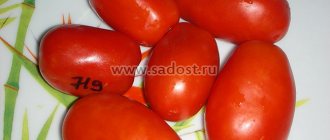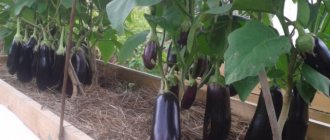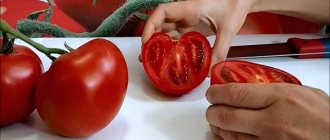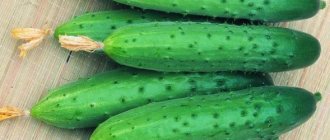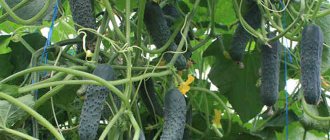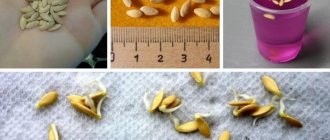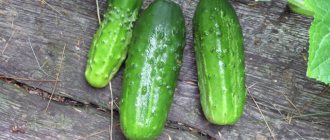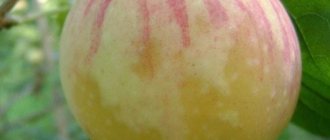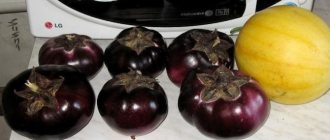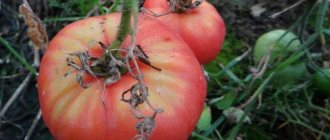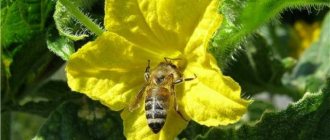The real Claudius cucumber is now almost impossible to find; it has been replaced by other hybrids. But when Claudia appeared, gardeners quickly tasted its taste and capabilities, and it gained enormous popularity. This is an early ripening, fruit-bearing hybrid, suitable for both greenhouses and open ground.
- 1.1 History of the hybrid
1.1.1 Video: Claudia Agro cucumber seeds
- 2 Appearance
- 3 Advantages and disadvantages, differences from other varieties
- 4 Features of planting and growing the Claudia variety
4.1 Landing
- 4.2 Care
Cucumber CLAUDIA reviews and photos of the hybrid
Claudia f1 cucumber has been in demand among summer residents for many years - and the main reasons for such popularity are the large number of positive qualities of this variety.
“Claudia” is classified as an early variety; it is also famous for its friendly yield of smooth, tasty cucumbers.
In addition, Claudius cucumbers are resistant to most diseases characteristic of other vegetable plants of the Cucurbitaceae family.
The main positive qualities of the Claudius cucumber hybrid, the nuances of cultivation, diseases and pests and much more will be discussed in this article.
The content of the article:
1. History of the variety 2. Description and characteristics of the Claudia variety 3. Productivity 4. Advantages of the Claudia cucumber variety 5. Diseases and pests 6. Cultivation and care 7. Reviews of those who planted this variety 8. Information from the manufacturer
Productivity
Cucumber Claudia F1 is a hybrid with bunched fruit set. Three ovaries are formed in one leaf axil. The first ripening of fruits is massive. With proper care in open ground, 1 m² can produce up to 10 kg of fruit, and in greenhouses - about 20-25 kg of cucumbers of good commercial quality. Productivity of the variety is 80-90%.
Claudius F1 cucumbers bear fruit for a long time, until the onset of severe cold weather. Young cucumbers are collected 1-2 times a day. A characteristic feature of the hybrid is the early yield of the crop. The first yield of commercial products varies in all climatic regions and averages 30-100 centners per hectare.
History of the variety
Hybrid Claudius f1 was created by breeders from the Dutch company Seminis, which has been developing new varieties of vegetable crops and selling seed material for many decades. Branches of this seed company are located all over the world, and the volume of seed imports increases every year.
In 2008, an improved version of this hybrid called “Claudine f1” was entered into the Russian State Register, the originator of which is the Dutch company Monsanto Holland BV. And “Claudine” was discontinued from production.
But the demand for the much-loved Claudius cucumbers remained high and Russian companies also began to produce seeds with that name. Among them are all the popular ones, “Sedek”, “Lucky Seeds”, etc.
In Russia, the Claudia cucumber variety is recommended for cultivation in open ground and greenhouse conditions in most regions.
Optimal timing for planting
Plant seeds in the soil only if it has warmed up to 15 degrees Celsius. At the same time, there should be no chance of frost returning. For planting work, the optimal temperature is 20-25 degrees Celsius.
Procedure:
- Before planting, fertilize the soil. You can use organic or mineral compounds. If the soil is quite heavy, then dilute it with sawdust. Thanks to them, aeration increases.
- Immerse cucumber seeds into Claudius soil 3 cm.
- To speed up the emergence of seedlings, cover the bed with plastic wrap.
Claudia f1 cucumbers are also suitable for growing in seedlings. To do this, you need to use the following tips:
- Before sowing, soak the seeds in a growth stimulator. Keep them there for 2 hours, and then lay them on cloth to dry.
- Pour a nutrient composition consisting of turf soil and peat, taken in equal proportions, into plastic cups. You can add 10 g of wood ash and superphosphate to them.
- Deepen the seeds, spray with water from a spray bottle and cover with film.
- And when 3 leaves appear, you can plant the seedlings in the greenhouse. Send the plants to open ground at the end of May.
You can sow the seeds directly to a permanent place or use the more traditional seedling method. Planting dates depend mainly on the climatic characteristics of the growing region. Regardless of the propagation method chosen, planting can be done only after the soil has warmed to 15°C.
In the southern regions, this period falls in the middle or end of May, in the northern regions - at the beginning of June.
When sowing seeds for seedlings, it is worth considering that it will take 5–6 weeks before sprouts appear that can survive in open ground after transplantation. In accordance with these calculations, it turns out that sowing should be carried out in early April - for the southern regions, at the end of April or early May - for the northern ones.
When growing cucumbers of the Claudia F1 variety, you should choose the right planting location. Preference should be given to well-lit places with neutral soil. The least acidic are soils on which garden crops such as potatoes, cabbage, and legumes were previously grown.
Important! It is not recommended to grow the same crop in one place for several seasons in a row. In particular, this rule applies to cucumbers.
The key to getting a good harvest of cucumbers is proper care, which includes:
- Abundant watering during dry periods.
- Systematic loosening of the soil 2-4 times a month.
- Feeding with micro- and macroelements.
- Regular harvesting.
- Growing on trellises in a vertical way.
- Timely formation and garter of bushes.
Claudia cucumber: description and characteristics of the variety
The Claudius hybrid is classified as an early ripening variety - about 1.5 months pass from the moment the first shoots appear until the harvest of ripening greens. These cucumbers belong to the parthenocarpic type, indeterminate, only female flowers appear on the vines, which do not require pollination by bees, and there are no barren flowers at all.
Photo of cucumber Claudius F1
To obtain higher yields, it is recommended to form Claudius cucumber vines into one stem and tie them to trellises or a special cucumber net. In this case, it is easier to care for the bushes of this vegetable crop and collect ripe greens.
The shoots of the cucumber variety Claudia are long, can reach 1.9-2.0 m in height and above, the formation of lateral shoots is average. The foliage is five-lobed, medium-sized, slightly wrinkled, dark emerald in color.
The ovaries are formed in nodes, collected in bundles of 5-7 pieces each. Fruiting is long-lasting, ripening cucumbers are of the gherkin type. Fruit ripening is uniform, stable throughout the season, independent of changes in weather conditions.
Important!
It should be noted that this variety of Claudia F1 cucumbers reacts negatively to lower temperatures - the growth of vines slows down, as well as the ripening of fruits.
It is also worth noting that when direct sunlight hits the foliage, burns can form on it. The sizes of small cucumbers are about 9 cm in length and 2 cm in diameter.
The weight of one fruit is about 85 cm. The shape of greens is cylindrical. The skin is dense, crispy, covered with small tubercles with small light spikes. Thin small light stripes and small light spots are clearly visible on the surface of cucumbers. The taste of ripe fruits is pleasant, slightly crispy, tender greens have a light cucumber aroma; at the genetic level, ripe cucumbers have no bitterness. The pulp has no voids, is dense and juicy. There are no seeds in it, and if they appear, they do not ripen.
The harvested cucumbers of Claudius f1 can easily be transported even over long distances, without losing their taste and beautiful appearance.
Claudius hybrid cucumbers do not overgrow, do not turn yellow or become rough even when overgrown. But experienced summer residents recommend collecting ripening fruits at the gherkin stage so that new ovaries appear on the vines faster.
Ripe greens are universally used, used for fresh consumption, added to salads and snacks. Pickled and pickled Claudius cucumbers taste great, crispy and tender.
The Claudia hybrid is characterized by average resistance to most diseases that affect other varieties of cucumbers, and tolerates heat and rainy seasons well.
Claudia's cucumber F1 - video
Reviews from vegetable growers
Claudia belongs to the mid-early hybrids.
From the moment of germination to the appearance of fruits, 50–60 days pass. The long vines of the plant give rise to a large number of lateral shoots, which makes it possible to conveniently place them on trellises when grown in open ground and greenhouses. One of the features of this variety is the female type of flowering. 2–3 ovaries are formed in one internode, which makes it possible to obtain a large harvest even when planting a small number of plants in small areas. This feature made the variety especially popular among farmers.
Medium sized fruits. Their weight varies from 60 to 90 g with a length of up to 12 cm. Small bumps are located on the surface of the elongated cylindrical fruit. The pulp of greens is dense, crispy, and exudes a pleasant aroma.
A notable feature of this variety is the lack of ability to produce large amounts of cucurbitacin, which completely eliminates the possibility of bitterness accumulation.
In addition, unlike other cucumber crops, Claudia tolerates temperature changes well when grown in open areas, which allows the plants to actively develop, bloom and continue the fruiting period until the onset of frost.
In addition, the variety does not lose its ability to bear fruit even with minimal watering in a relatively dry climate.
Did you know? Cucumber is 95% water. Moreover, cucumber pulp contains water in a perfectly purified form.
After planting cucumbers, care consists of the following activities:
- fertilizing;
- watering;
- soil aeration.
The watering regime is selected in accordance with weather conditions and is carried out:
- daily - in hot weather;
- once a week - on cloudy days.
On average, 3 liters of water are spent per bush.
Did you know? Cucumber juice can replace motor oil. If the doors in your house squeak, just lubricate them with cucumber juice - you will be pleasantly surprised by the effect.
Fertilizing is combined with watering:
- The first is carried out a month after transplantation with a yeast solution. To do this, dissolve 12 g of yeast in 5 liters of water at room temperature and add 100 g of sugar. The liquid is infused for a week at a temperature of 30°C. After this, add water to the solution to make 10 liters, and add 1 liter to each bush. When combined with watering: apply 1 liter of fertilizer in the morning, and water 2 liters per bush in the evening.
- The second feeding is carried out after 10 days. At this stage, you can use an infusion of ash and nettle. To 5 liters of boiling water you need to add 100 g of ash and 0.5 kg of nettle. The liquid is infused for a day, filtered and mixed with water 1:1. Nettle can be used as mulch.
During the active fruiting phase, foliar feeding is carried out. A yeast solution will do. Only for spraying it needs to be diluted with water in a ratio of 1:5. A day after the “yeast shower”, spraying with plain water is carried out.
A support up to 2 m high is installed next to each plant. Several ropes are stretched from the support, onto which lashes begin to be tied as they grow. The main whip is tied to the rope when it reaches a height of 15 cm.
When grown in open ground, the growth point is pinched at a height of 100 cm, in a greenhouse - at a height of 120 cm. The side lashes of the first order are shortened to 50 cm, the second - to 15 cm.
All manipulations are carried out with a sharp instrument disinfected in alcohol. After pruning, the affected tissues are treated with a mixture of ash and Fundazol, combined in a 1:1 ratio.
Soil care
The soil around the main stem is loosened to a depth of 5 cm, in row spacing - 10 cm once every 2 weeks.
Important! With high-quality mulching in hot weather, watering is carried out not every day, but once every 3 days.
In parallel with loosening, weeds are removed. Immediately after this, the soil is mulched with compost or fresh lush grass.
Summer residents call the hybrid consistently fruitful. To increase yields, many grow cucumbers in manure beds with sides.
Claudia F 1, according to reviews from gardeners, is suitable for pickling and canning, and can be stored fresh for a long time without losing its taste.
The advantages of Claudia F1 include high productivity and unpretentiousness, the pleasant taste of vegetables, as well as the possibility of using them in pickling. Among the disadvantages are the inability to grow plants from personally collected seeds and susceptibility to mosaic and powdery mildew. Thus, the hybrid has many more advantages and they more than cover the disadvantages.
The culture in question is distinguished by long and powerful fences:
- The fruits themselves have a smooth surface with minor pimples. The shape of the vegetables is cylindrical. One cucumber weighs 60-100 g, length is 10 cm. The fruits are not bitter, so they are suitable for fresh consumption, canning, pickling and pickling.
- The pulp of cucumbers is juicy, aromatic, slightly sweet. It contains small grains. Even in overgrown fruits they are not large. The next advantage of the Claudia F1 variety is its high yield. From 1 m2 you can get up to 27 ripe and tasty cucumbers.
The fruits of the Claudia F1 variety are distinguished by their even green color. The surface of the cucumbers is finely tuberous, rough in appearance, the skin is very tender and thin. They do not have pronounced pimples, ribbing, or stripes. The variety is universal - suitable for both pickling and fresh consumption.
The beautiful appearance of the fruit is one of the advantages of the variety.
The variety is very productive: if agricultural techniques are followed, up to 27 kg of fruit can be harvested from 1 m2 of plantation. The first cucumbers appear 45–50 days after sowing. The weight of the greens is approximately 60–100 g, the diameter is about 3 cm, and the length is 10–12 cm.
Cucumbers of the Claudia F1 variety are self-pollinating
The fruits of the Claudia F1 variety are ready for consumption when they reach a length of 10–12 cm. With abundant ripening, cucumbers can be harvested daily or every 2 days. But breaks of 3 days are possible, since this variety is not prone to overgrowth. When harvesting vegetables, the stalks should be left on the stem.
It is recommended to pick fruits without the stalk
Placed in a plastic bag in the refrigerator, cucumbers of this variety can be stored for quite a long time (at temperatures up to 8 oC - one week, and at temperatures 0-4 oC - more than two weeks).
Claudia F1 is a cucumber variety with tasty and beautiful fruits. These vegetables are universal in use - they are good both fresh and pickled. The variety is suitable for growing in open ground.
Claudia F1 is a universal hybrid variety with good properties, cultivated in almost all southern regions. Thanks to its complex disease resistance and high yield, it has gained popularity among gardeners from agricultural enterprises.
Claudia F1 is a mid-early parthenocarpic hybrid, female flowering type. Suitable for growing in open and closed ground: direct sowing or seedling method. Tolerates shade, so can be grown on balconies and window sills. The ripening period for cucumbers of the Claudia F1 variety is 45-52 days from the moment of emergence.
Main characteristics of cucumbers of the Claudia F1 variety:
- indeterminate hybrid;
- medium leafy;
- climbing;
- leaves are slightly wrinkled, dark green.
These are universal cucumbers. Suitable for all types of processing and for fresh consumption. This hybrid is the best pickling variety. Young cucumbers are small in size, which makes them fit well into small jars, maintaining their elasticity and original shape.
Description of the appearance of Claudius F1 cucumbers:
- length - 10-12 cm;
- thickness - 3-4 cm;
- average weight - 65-90 g;
- cylindrical shape;
- slightly ribbed, with slight pubescence and pimples;
- thin-skinned;
- with small seeds (even in overgrown cucumbers);
- bright green in color with stripes reaching up to 1/3 the length of the cucumber.
Young fruits have a bright cucumber aroma. The pulp is juicy and crispy, tender, sweetish in taste, without characteristic bitterness. Cucumbers do not fade for a long time, maintaining their characteristic external and taste qualities.
There are two ways to grow cucumbers: seedlings and non-seedlings.
Direct sowing of seeds in open ground takes place in late spring or early summer. These dates vary depending on the region in which the planting takes place. You should also pay attention to weather conditions. It is recommended to sow the seeds of Claudius F1 cucumbers after warming the soil to 18-23 °C. In the southern climate zone, sowing can be carried out in several stages, with intervals of 2-3 weeks.
Pre-sowing preparation involves adding organic fertilizers to the soil and watering. Then, 3-4 seeds are placed in the prepared holes, located at a distance of about 40 cm from each other, to a depth of 2 cm. Planting can be done in rows or in a nesting method. Cucumber plantings should be covered with film until the emerging sprouts become stronger.
Advice! Pre-soaking the seeds will increase germination. To do this, they are placed between two layers of cloth moistened with water. The fabric with the seeds is wrapped in plastic wrap and kept for about two days in a warm place.
Planting seedlings in the ground allows you to get an early harvest. Sowing seeds for seedlings is carried out in the first ten days of April. The most favorable period will be 25-30 days before the expected planting in the ground.
Advantages of the cucumber variety Claudia
The main advantages of the Claudius hybrid include:
- high productivity;
- friendly ripening of the cucumber harvest;
- fruiting throughout the summer;
- the harvested cucumbers tolerate transportation well;
- excellent presentation of the collected greens;
- wonderful taste of ripe cucumbers, without bitterness;
- resistance to most diseases;
- ripe fruits are gherkin-type, therefore ideal for canning and pickling;
- The Claudia cucumber hybrid can be grown in open and closed ground.
But the variety also has a number of disadvantages:
- Cucumber of the Claudia variety can be affected by white and green mosaic, root rot, powdery mildew;
- The delicate foliage should not be exposed to direct sunlight, otherwise sunburn will appear on the leaf blades.
Due to the possibility of infection by some diseases, it is recommended to treat plants with Bordeaux mixture for preventive purposes.
The best cucumbers!
• Hybrid EMERALD STREAM • Cucumber hybrid MASHA F1 • Cucumbers FRIENDLY family
Recommended by topic
Cucumbers August 16, 2020
How to grow cucumbers in the garden
Read more
5 / 5 ( 1 voice )
Cucumbers August 16, 2019
Growing cucumbers in Siberian cold conditions
Read more
Cultures June 9, 2019
The best cucumber seeds
Read more
Cucumbers August 16, 2020
How to grow cucumbers in the garden
Read more
5 / 5 ( 1 voice )
Cucumbers August 16, 2019
Growing cucumbers in Siberian cold conditions
Read more
Growing July 27, 2019
Pink giant tomato
Read more
Diseases and pests affecting Claudius cucumbers
Sometimes the vines of this vegetable crop can be affected by a number of diseases, in particular:
- root rot
- the main symptoms of the disease are yellowing and cracking of the lower part of the shoots, wilting of cucumber foliage. You should sprinkle the affected areas with wood dust and treat the soil and plant with copper sulfate. Until the cucumbers have recovered, you should not loosen the soil around them. And also avoid watering with cold water; - powdery mildew
- a light coating appears on the foliage, the leaves dry out and fall off, then the entire vine may die. Diseased plants are treated with a soap solution to which soda ash has been added. You can also use solutions of fungicides, which are diluted strictly according to the instructions for use. All affected areas on cucumbers must be removed, and the number of nitrogen-containing fertilizing must be reduced. Watering should be carried out only at the base of the plants, making sure that moisture does not fall on the foliage and stems; - green mosaic
- the affected parts of the plants become yellowish and wrinkle. Affected cucumbers are transplanted to another place; crop rotation rules must be followed; - white mosaic
- characteristic spots of white and yellowish color with characteristic stars appear on the foliage. Affected plants will have to be destroyed, since there are currently no effective measures to combat the disease.
Cucumber Claudia F1 - photo
Cucumber vines can also be affected by aphids, spider mites or thrips. These insect pests can be controlled using both folk remedies and the use of insecticides.
We grow seedlings
The technology of sowing seeds directly to a permanent place is advisable in the southern regions and for cultivation in greenhouse conditions. In the northern regions and central zone, the method of seedling cultivation is more acceptable.
With any of the chosen methods, the soil on the site begins to be prepared in advance, even during the autumn harvest. To do this, the soil is dug up 2 times with an interval of 10 days to a depth of 20 cm. After the first cultivation, the soil is treated with a 3% solution of Bordeaux mixture.
Did you know? Cucumber pickle is an excellent hangover cure. The thing is that alcohol quickly removes water from the body, and the salty marinade retains this same water, which allows you to quickly restore the electrolyte balance.
After the second, 10 kg of manure and sand, 300 g of superphosphate or 400 g of wood ash are added to each m² and dug again to a depth of 15 cm.
Seedling method
The soil for seedlings should be nutritious and loose.
To disinfect the soil and enrich it with phosphorus, potassium and calcium, water it with a hot solution containing wood ash. To do this, add 300 g of ash to 3 liters of water and boil for half an hour. After removing from the heat, the liquid is immediately poured into the soil. 3 liters of solution is enough to disinfect 10 kg of soil.
Before planting, seeds can be placed in a solution of the Silk preparation. It is dissolved according to the instructions in 200 ml of hot water. After 15–20 minutes, immerse the seeds in liquid for 2 hours, then dry them on a paper towel and begin planting.
To sow seeds, it is best to use peat cups or coconut tablets. This approach eliminates the need to additionally replant seedlings before the main picking.
In addition, it becomes possible to protect plants from traumatizing the rhizome at the time of the main transplantation, since the seedlings are placed in the holes along with containers, which subsequently decompose and additionally enrich the soil with nutrients.
The containers are filled with prepared soil, the humidity of which fluctuates around 80%. 2 seeds are placed in each glass to a depth of 1 cm. Then the surface of the container is covered with film to create a greenhouse effect and set aside in a darkened room.
The air temperature in the room should fluctuate between 20...
With the appearance of the first sprouts, the containers should be moved to a bright room, the films should be removed and the air temperature should be reduced by 5°C. The seedlings need to be thinned out, leaving 1 sprout. From this point on, watering is carried out through a spray bottle with water at room temperature after the soil has dried to a depth of 1–2 cm.
With the appearance of 2 true leaves, the plants begin to be fed. You can use an ash solution made according to the above scheme. After cooling to room temperature, it is collected in a spray bottle and the leaves and soil are sprayed. You can also use the drug "Silk".
To use as a fertilizer, it is diluted according to the instructions, and after cooling, the required amount of water is added. Use similarly to ash solution. Before transplanting, one feeding will be enough.
Important! To prevent the seedlings from stretching and overgrowing, the temperature is reduced by several degrees at night. The gap between day and night temperatures should not exceed a threshold of 5°C.
2 days before transplantation, the temperature in the room should be gradually reduced to the average daily street temperature. 5 days before transplanting, the seedlings gradually begin to be taken outside, first for 3–4 hours, increasing this interval every day. The seedlings should spend the last 24 hours before planting in containers in a new location.
The place for sowing seeds should be well-lit with fertile soil. A month before planting, the soil is cultivated according to the autumn scheme.
Seeds are processed in the same way as with the seedling propagation method. Immediately before planting, trenches are formed 2 cm deep. The distance between the trenches is 40 cm. The seeds are laid out at a distance of 5 cm from each other and covered with soil.
When the sprouts reach a height of 5 cm, they are thinned out, leaving the strongest ones at a distance of 15 cm from each other.
Since Claudia F1 does not tolerate heat well, you should choose a place that is lit in the morning and has good shade in the afternoon, when the air temperature reaches its maximum. The cucumber feels good among tall plants that protect from the sun and serve as support for the stem.
The crop is not resistant to powdery mildew and peronospora, therefore, to prevent these diseases, it should not be planted in places where melons (zucchini, squash, watermelons, pumpkins) have recently grown. If this is not possible, then before digging the soil is disinfected by sprinkling with quicklime or treating with a solution of copper sulfate.
During autumn digging, ammonium nitrate containing sparingly soluble phosphates is added to the soil. Nitrogen and potassium are washed out by water, so they are added in the spring before planting. To do this, sprinkle the bed with ash and well-rotted humus, level the soil and water it with water.
You can add ash and humus during planting. To do this, add a scoop of a mixture of ash, humus and garden soil to the prepared hole, after which seedlings or seeds are planted.
Sprouted seeds are planted in containers pre-filled with soil.
Make a 3–4 cm depression in the ground, place a seed in it and sprinkle it with soil. To create a greenhouse effect, pots with seeds are covered with glass or other covering material and placed in a warm place until germination.
When growing seedlings in the second half of February - early March, take care of additional lighting. A lack of red and blue colors in the light spectrum will lead to the death of the plant. Phytolamps that generate light of the required brightness and spectrum save plants from death. It is not recommended to use them at home without additional protection, since the emitted light is harmful to the human body.
In recent years, LED lamps have become excellent substitutes for phytolamps. They completely compensate for the lack of light for complete photosynthesis of the plant. The light intensity should be 6000 lumens.
An LED lamp for a table lamp is quite suitable for illuminating cucumber seedlings
The phytolamp ensures the full development of plants when there is a lack of natural light
Phytolamps have become a permanent attribute of modern greenhouses
A powerful phytolamp consists of several LED modules
Cucumber seeds are planted in the ground when the soil warms up to 16–18 °C and the air temperature rises to 20–24 °C. Without complying with these requirements, seedlings will not work - the seeds will die. At approximately 5–6 days, the first shoots appear. With sufficient watering and a comfortable temperature, without sudden changes, the first true leaves will appear in a week. If there is a threat of frost, the seedlings must be protected with film or agrofibre.
The distance between plants should not exceed 10 cm, between rows - 60 cm. After the seedlings have become stronger, the plantation is thinned out, leaving a distance of 30–35 cm between the cucumber bushes.
If necessary, such a greenhouse can be easily moved to another place
For a tunnel greenhouse you need arcs, which you can buy or make yourself from coarse wire or plastic pipes, or use strong hazel branches that bend easily
During freezing, you can cover the plants with plastic bottles without a bottom.
The greenhouse retains heat and significantly accelerates the growth of seedlings; the crop ripens here much earlier than in open ground
Claudia F1 is considered a medium early hybrid with a female flowering type. It was created for cultivation in open ground conditions, as well as in greenhouse conditions. In the territories of the Central Black Earth region, as well as in the Krasnodar Territory, it is grown using the soil seed method. The remaining climatic zones of the country are suitable for planting seedlings in late spring or early summer.
The yield of the variety depends on the growing conditions. Planting heated greenhouses on the soil allows you to harvest twice as much harvest.
Claudius cucumbers: cultivation and care
Claudius cucumbers are grown both in seedlings and without seedlings. In the second case, the seeds are sown directly into the ground on previously prepared beds. It is advisable to cover the crops with plastic film on top to protect the seedlings from possible return spring frosts.
For seedlings, Claudius cucumber seeds should be planted approximately 28-30 days before transplanting them to a permanent place in the garden or greenhouse. If the seedlings outgrow at home, they will take a long time to acclimatize after planting in the beds; as a result, the first ripe fruits may appear on such bushes much later than the period stated in the description.
The width of the prepared beds should be no more than a meter, on which cucumbers are planted in two rows. Furrows are made in the soil, watered well, complex mineral fertilizers are added and seeds or ready-made seedlings are planted. It is recommended to place no more than 3 cucumber plants on one square meter.
Review of cucumber variety Claudia F1
Further care for growing Claudius cucumber bushes is as follows:
- in compliance with the irrigation regime;
- in regular loosening of beds and removal of weeds;
- in feeding this vegetable plant several times a season.
Watering cucumbers should be regular - at least 2-3 times a week, and in hot weather the frequency of watering increases. When watering, you need to try to prevent water from getting on the foliage.
Claudius cucumbers need to be fed frequently - about once every 12-14 days - to increase the yield of the bushes. Organic and mineral fertilizers are usually alternated.
Care
Claudia F1 needs care. For starters, this is regular watering with warm water in the mornings and evenings. It is necessary to moisten at the root to avoid moisture getting on the tops of the bush and its further burning. Removing weeds is a mandatory cultural issue. Lightly loosening the soil after moistening it will be an excellent incentive for good growth of stems and roots.
Fertilize once every 10-12 days. Organic infusions:
- ash;
- mullein;
- urea.
If you choose chemical fertilizers, the best options are azophoskas, nitrophoskas (plus mullein infusion) and sodium humates (can often be mixed with urea and ash).
To protect against unwanted pests from other bushes, a fungicide comes to the rescue:
- Previkur;
- Thanos;
- Actellik.
Since the bushes produce long lashes, they need to be pinched and tied up. The most important thing is to limit your height to around 1 meter in an open space, and 1.2 in a closed space. The side stems should be 50 cm long, and their shoots should be 15 cm long. This will ensure maximum yield from all vines.
Advice!
If the cucumbers are in a greenhouse, then you need to ventilate it properly, keeping the air humidity in the region of 75-80% and the temperature from 18 to 25 degrees.
Cucumber “Claudia”: reviews from those who planted this variety
Gardeners in many regions of Russia are engaged in growing this variety, and then leave their reviews on forums. Some of the reviews about the Claudius hybrid are presented below:
Ella, 39 years old, Nizhny Tagil:
In our region, such a heat-loving crop as cucumbers is best grown in greenhouse conditions. I have been growing Claudia gherkin cucumbers for several seasons now. I like the fairly rapid ripening of the fruits, the plants do not require special care, and we use the harvested crop not only fresh, but also pickle and salt it.
Tatyana, 40 years old, Ryazan:
I grow this variety in beds in the garden. Although the variety requires shaping and tying to trellises or cucumber mesh, it is easier to care for the bushes and it is easier to collect ripe greens. The yield is quite high, but my neighbors planted these cucumbers in a greenhouse and say that their yield of this hybrid is much higher than what I have in my open ground beds.
Stella, 50 years old, Tambov:
This is not the first year I have been planting the Claudia cucumber variety. As a result, we collect ripe cucumbers within 1.5 months after germination, and small ripe fruits are ideal for preservation.
Inna, 49 years old, Voronezh:
This is not the first season I have been growing early varieties of cucumbers. Basically, I use the harvested crop for further sale, since my cucumbers appear earlier than others. Therefore, I also plant the Claudius hybrid in the beds, since the harvest of this variety has an excellent presentation and good taste. Last year I planted this hybrid in a greenhouse and harvested more than 2 times more than I had previously collected in the garden from the same variety.
CHOOSE!
• The best varieties and hybrids of cucumbers for 2021 for greenhouses
Elena, 46 years old, Volgograd:
I would like to note the friendly ripening of the harvest of the bushes of this variety. Claudius's gherkins are delicious, without any bitterness at all, even if they were not picked in time. And the vines bore fruit almost all summer, but they had to apply fertilizer every 12-14 days.
chwedwa02:
I have been planting this variety of cucumber for a very long time, I still remember my grandmother planting it.
With the Claudia cucumber there is never a bad year. The cucumber is without bitterness; when pickled, it turns out crispy and without voids. I think this is one of the best varieties for pickling. I really like that the variety is finely tuberculate, and its ripening is average. The cucumber is a self-pollinating gherkin approximately seven to ten centimeters. I first plant seeds at home for seedlings, but if you plant Claudia in a greenhouse and not in open ground, you can plant the seeds directly into the greenhouse. https://otzovik.com/review_382159.html
eleersho2014:
I am a gardener with only 5 years of experience.
Although I always plowed in other people’s gardens, I didn’t feel any joy. And at 50, I got the bait: I want a garden, a vegetable garden and a greenhouse! The question arose about choosing a variety of cucumbers - I planted whatever I could find. I just discovered the Claudia F1 variety! Neat cucumbers, slightly sweet. Small pimples, small seeds. And eat well, and for pickling. And in combination with their small neighbors - Cherry tomatoes - it’s simply great. The neighbors praise me. and I am pleased. The whole family loves these cucumbers, my daughter especially praises them. And the one-year-old grandson, who is still toothless, has already appreciated it - he spends his time with pleasure. In the Urals we have gardens and vegetable gardens that are a joy! Everything grows, especially in greenhouses. https://otzovik.com/review_1271729.html
Galka58:
Every year, for about 15 years now, I have always planted cucumbers of the “Claudia” variety; the seeds were the first, then their quality deteriorated sharply, and I switched to seeds from other companies.
Previously, there were 15 seeds in bags, then 10, and now they put 8 seeds. This cucumber variety is the best for me at the moment. Cucumbers never outgrow, there are no voids, the seeds are small, soft, the flesh is slightly creamy in color. Cucumbers have stable and long-term fruiting. When the foliage of other varieties has already turned yellow, “Claudia” is still green and continues to delight with cucumbers. https://irecommend.ru/content/na-protyazhenii-mnogikh-let-obyazatelno-sazhayu-klavdiyu
Thanks to its positive qualities, the cucumber hybrid Claudia is becoming increasingly popular among Russian vegetable growers, who grow it not only for personal needs, but also for further sale of the harvested crop.
Features of harvesting and storage
The first fruits ripen approximately 6 weeks after emergence. At this time, the first harvest is carried out, after which the fruit is selected every 2 days. By this time, the cucumbers should have lengthened to 5–8 cm. It is best to pick the crop in the morning or evening, on a dry and sunny day.
You need to separate the ripe fruit from the stalk using a sharp kitchen or garden knife. Then the collected cucumbers need to be placed in baskets or deep containers for vegetables - they serve as temporary containers, from which the fruits are subsequently delivered to a permanent storage location. Manipulations with fruits are carried out carefully; during selection they should not be damaged, as this sharply reduces their presentation and shelf life.
Selected fruits are stored in a dry and cool place at a temperature of about +5°C for 1 month after selection. Without special conditions, the shelf life of Kolibri cucumbers is no more than 14 days, and at the same time the taste and aromatic properties of the crop gradually decrease. To preserve the harvest of cucumbers throughout the winter, it is better to pickle them.
Kolibri F1 cucumbers are a productive fruit hybrid, unpretentious and high-yielding. This variety can be successfully grown both in open soil or greenhouses, and on a windowsill. And if you take into account all the features of growing this crop, you can regularly get an excellent harvest of fresh cucumbers.
Claudius cucumbers f1: description and characteristics from the manufacturer
An early-ripening parthenocarpic hybrid for growing in open ground under temporary film covers. The plant is climbing, with bouquet formation of ovaries (more than 3 per node). The greens are cylindrical, finely tuberculate, green to dark green, with short stripes, white pubescence. Fruit length 10-12 cm, diameter 3-4 cm, weight 64-89 g. Recommended for pickling and pickling, suitable for fresh consumption.
Grow by seedlings or direct sowing in open ground. The hybrid is valued for its high marketability and taste qualities of fruits, complex resistance to cucumber diseases, friendly and stable yield of early harvest. Productivity 2.1-4.8 kg/m2. Package size 150x80x2 mm.
Manufacturer: Aelita, Euro-seeds, Gavrish, SeDek, Plasma seeds, Russian vegetable garden, etc.
Soil requirements
To obtain a rich harvest, it is necessary to take full responsibility in choosing the location and quality of the soil for planting seeds or cucumber seedlings.
Cucumber is a heat-loving crop and therefore, when planting, you need to choose a sunny place with fertile soil.
A correctly chosen location increases seed germination and seedling survival rate:
- beds for planting cucumbers in open ground are prepared in a well-lit place, without drafts;
- the soil should be neutral acidity, loose and moisture-absorbing;
- when preparing beds in the fall, it is necessary to add organic matter, in the form of manure, and phosphorus-potassium fertilizers to the soil;
- during spring preparation, add compost or humus.
